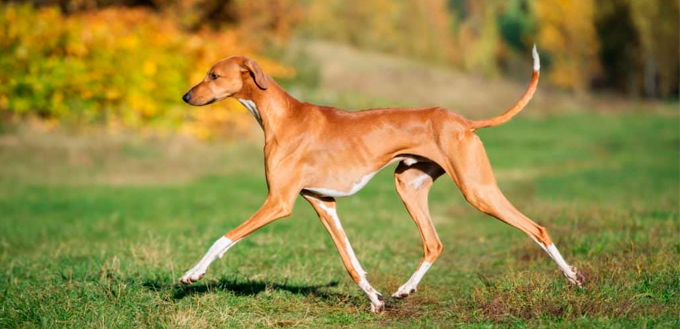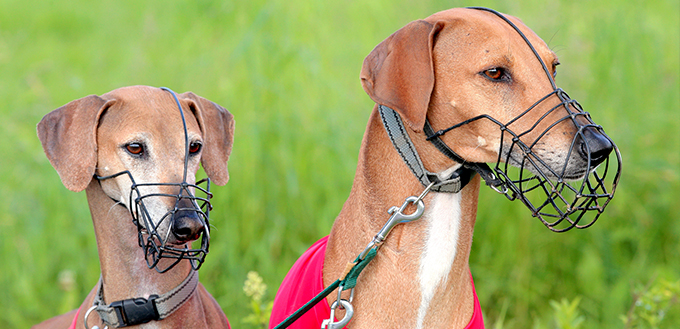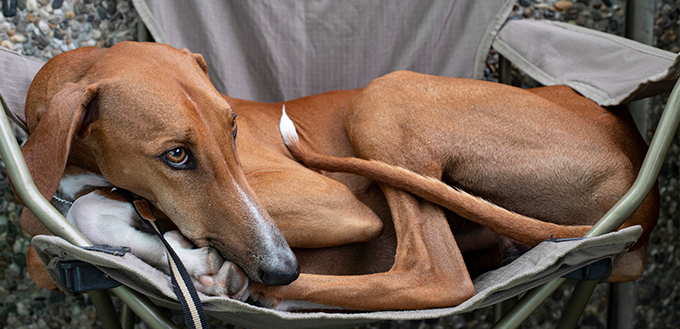Sleek and distinguished, aloof yet loyal, the gentle Azawakh is an affectionate companion, without the clinginess that other breeds often exhibit. It might not be the most famous of dogs, but we strongly believe that this beautiful pooch deserves a little more attention.
These leggy hounds hail from Western Africa, where they were bred to hunt for, guard, and travel with their nomadic human family. This role required a protective nature and fierce loyalty, which the breed retains to this day. If you’re thinking about introducing one of these elegant dogs into your home, read on, as we run through some important information about the ancient breed. Below, we discuss the Azawakh’s rich history, personality, and unique care requirements.
See our round-up of the Best Food for Hunting Dogs.

History of the Azawakh
The Azawakh is a type of sighthound, originally bred in the Southern Sahara, around modern day Mali and Niger. Sight hounds are named for their tendency to track down prey with their eyes rather than their noses. Named after the Azawakh Valley, the ancient breed was recognized by the United Kennel Club in 1993.
Azawakhs were developed among the nomadic Tuareg people, which is why you’ll sometimes hear the breed referred to as ‘Tuareg Sloughi’. Another name for the breed, ‘Idii n’Illeli’ roughly translates as ‘noble dog of the free people’.
We don’t know exactly when these beautiful dogs first came to be, but we do know that they share common ancestors with the Saluke and Sloughi breeds. Both of these dogs also have their roots on the African continent. Whenever they first appeared, it’s clear that the Azawakh plays an important role in Tuareg family life, helping their human companions to hunt animals, and stay safe. So valued are Azawakhs that they’re even allowed to sleep inside their owner’s tent at night.
Although they’ve been around for hundreds of years, it wasn’t until the 1980s that the Azawakh made it to American shores. Today, the breed can compete in the American Kennel Club’s Miscellaneous Class, along with agility events and lure coursing. Because of their speed, dexterity, and intelligence, the Azawakh is especially at home in agility competitions.
Check out our review of Dog Agility Tunnel.
Quick Facts
Azawakhs are a rare breed in the US, so it can be difficult for prospective owners to get a handle on exactly what they’re like to own. Before we delve into the details, we’ve uncovered some quick facts to give you a rough idea of what this unusual breed is really like.
- Azawakhs are usually tan, fawn or sandy in color, blending in with their Saharan heritage. Some animals take on black, grey, or brown colors, too.
- Thanks to their desert origins, Azawakhs can withstand very hot temperatures – they won’t enjoy living in a cold or rainy climate. If you like the sound of the Azawakh but don’t live in a sunny area, consider adopting a Borzoi. The breed has a similar look and temperament to the Azawakh, but was bred in chilly Russia.
- Most Azawakhs are uniquely challenging to rehome, because they become so attached to their human families. If you’re considering taking in an Azawakh puppy, know that they’ll be happiest having a home for life.
- Azawakhs are typically a very quiet animal, saving their barks and howls for when it’s time to raise the alarm.
- Adopting an Azawakh might not be the best idea if you have cats or other smaller animals. Their prey instinct is strong that a chase will probably ensue.
- Despite their strong build and relatively large size, Azawakhs are happy to adapt to apartment living provided they have a daily walk or run of at least 30 minutes.
- Although they’re not as fast as greyhounds, Azawakhs can reach impressive speeds – as high as 40 miles per hour.
- Azawakhs are not well-suited to homes with young children. They’re generally calm, and can find the insistence of toddlers stressful to deal with.
- With their love of running, Azawakhs make excellent jogging companions – especially if distance running is your thing.
- Azawakhs were bred in a hot climate, and have very little fat. To help them rest comfortably, and maintain healthy bones, they require cushioned bedding.
You may also like our article on the Best Dog Beds.
Things You Should Know
Although Azawakhs are known for their quiet, dignified demeanor, don’t be fooled into thinking that they’re maintenance-free. Like any dog, it’s vital that you and your household are properly prepared before introducing an Azawakh into your midst.
To help you work out if this breed is right for you, and get things ready for your pup, we run through some crucial information about appropriate Azawakh care.
Training
Azawakhs were bred as a multifunctional dog: they hunted hares and antelope, acted as watchdog, and kept their human family company. With all these skills, you won’t be surprised to learn that the Azawakh is a very intelligent breed.
For this reason, training an Azawakh is a relatively straight-forward affair. The main thing to bear in mind is that these gentle dogs don’t respond well to aggression from their owners. Firm words and punishments can cause them to shut down, and make future training sessions more difficult. Swap out punishment for positive reinforcement, and you should have no problem with your dog.
Azawakhs develop quickly, and it’s a good idea to start socializing and training them from an early age. This is particularly prescient if you have other dogs in the house. As we mentioned earlier, this breed has a very strong prey drive, and is liable to chase their furry friends. If introduced at an early age, however, Azawakhs should have no problem interacting with smaller dogs. If you leave training too late, it can become tricky, as the Azawakh’s independence morphs into a headstrong personality.
If possible, enrolling your Azawakh puppy in a training class can kill two birds with one stone. Not only will the class give them ample opportunity to interact with other dogs (and humans) early on, it can also be very helpful to have an expert on hand to support your training journey. Trainers will quickly be able to tell whether your fiercely independent pooch is on track for success.

Feeding
Azawakhs are built to run and hunt efficiently, so they don’t require as much protein as you’d expect. Although meat should still constitute the bulk of their diet, Azawakhs will benefit from the addition of bananas and carrots to their diet.
When choosing food for your Azawakh, make sure that a recognizable meat is the first ingredient. Having evolved with nomadic people, it’s unlikely that the Azawakh would have naturally consumed many grains, so selecting a grain-free dog food is also a good option.
To support your dog’s heart, it’s also a good idea to choose a food that contains taurine, while their mental development will benefit from DHA. Like all larger breeds, your Azawakh will benefit from calcium and phosphorus, to support their teeth and bones, as well as omega-3 and 6 fatty acids, and other supplements for their joints.
To keep your new pooch in tip-top condition, the average Azawakh should be fed around 9 – 12 ounces of complete food each day. If in doubt your vet can advise you about feeding quantities.
Take a look at our review of the Best Automatic Dog Feeders.
When your Azawakh is still a puppy, they should be fed a diet specifically designed for young dogs. This type of food will have a much higher fat content, supporting their growth into a healthy adult. Dry puppy foods also feature small kibbles, making it easier for your pup to eat.
Grooming
Azawakhs have pretty short, sparse coats – long, thick hair would do them no favors in the desert heat after all. For this reason, they’re a great dog for allergy sufferers, since they aren’t prone to shedding. Thanks to their short coat, Azawakhs are also pretty easy to groom.
You will need:
- Slicker brush
- Deshedding Brush
- Nail clippers
To help your pooch maintain a healthy coat, you should:
- Brush your dog weekly with a firm-bristle slicker brush. This will remove any excess hair, and prevent it from matting, or ending up on your carpet.
- Trim your dog’s nails around once a month. Short nails help dogs to stay balanced, and hold themselves comfortably. Since Azawakhs are so athletic, good posture is vital to help prevent injury.
- Because Azawakhs have floppy ears, owners should check them for redness and swelling every week. If dirt appears, gently wipe them down using a dog ear cleaner.
- Like every breed, Azawakhs can benefit from regular tooth brushing. Everyday brushing is best, but you can also supplement weekly brushing sessions with dental chews. Good oral hygiene not only improves your dog’s breath, it also helps to prevent conditions such as gum disease and abscesses.
- Bathe your Azawakh monthly, to prevent excess oil build-up on their coats. This will prevent their coat from looking dull, and keep doggy smells at bay.
Although the Azawakh is a relatively low-maintenance dog in the grooming department, there is clearly still work to be done.
Check out our guides on dog hair clippers, puppy tear stain remover, brushes for short hair dogs and dog bath tub.
Health
Like any breed, Azawakhs are susceptible to a few particular health problems:
- Bloat
Deep chested dogs – Azawakhs included – are more prone to a condition called ‘bloat’, in which their stomach is filled with air, expands, and twists. Vets aren’t sure what causes bloat, but we do know that this twisting can cut off blood flow, making it more difficult for blood to travel to the heart. If your dog is suffering with bloat, you will notice a swollen stomach, retching, and restless behavior. If you notice these symptoms, take them to your vet immediately. Bloat can be treated by surgically untwisting the stomach.
- Eosinophilic Myositis
This immune condition causes a dog’s masticatory muscles to swell, and shrink, making it difficult for them to open their mouth. Symptoms include pain, swelling, and trouble eating or drinking. It can be treated with immunosuppressants and steroids.
- Skin Allergies
With so much of their skin exposed to the world compared to other breeds, Azawakhs can sometimes suffer from skin allergies. Look out for unusual itching, rashes, bumps, and hair loss, all of which suggest allergies. Although there is no ‘cure’ for skin allergies, they are not life threatening and can be managed with antihistamines or desensitization.
- Wobbler’s Disease
This condition is most common in larger dogs, so it’s worth being aware of if you want to adopt an Azawakh. Caused by compression of the spinal cord or nerve roots, the syndrome is characterized by a wobbly gait and neck pain. Treatment is usually surgery, followed by a few months of strict rest.
Although these conditions are worth watching out for, it should be noted that Azawakhs are generally healthy, hardy animals, with a lifespan of 10 – 15 years. Because they’re so hardy, these dogs are often oblivious to pain, so it’s a good idea to check them over every few days for any signs of disease or injury.

Exercise
Although they’re happy to relax quietly with their owners, Azawakhs are athletic dogs and require at least 30 minutes of exercise each day. They don’t like to run on their own, and will require you to actively walk them – 30 minutes of outdoor time just isn’t enough. Because of their tendency to give chase, it’s a good idea to keep your Azawakh on a lead unless you’re exercising in a fenced-in area.
One great way to channel an Azawakh’s athleticism and intelligence is to try agility training. The exercise is physically demanding, mentally stimulating, and gets owners on their feet, too. Azawakhs also make excellent running companions, as we mentioned earlier.
Temperament
Azawakhs are nothing if not loyal. They tend to be aloof with strangers, yet form deep and lasting bonds with their human family. Although they’re very independent, and rarely needy, Azawakhs still crave affection and attention from their owners.
Gentle and distinguished, Azawakhs aren’t a fan of the rough play that other breeds thrive on. This means they’re not a good fit for households with young children, who may inadvertently frustrate the dog with their antics.
Typically very quiet, Azawakhs will only bark and howl to raise the alarm, making them excellent guard dogs. Their high intelligence makes them easy to train, so long as you start early and take the right approach, but it does mean that they require plenty of stimulation – again, agility training can fulfill many of their needs in one fell swoop.
They might not be the typical bouncy family dog, but the loyal and stoic Azawakh continues to earn a beloved place in many homes.
Source:
- Azawakh, VetStreet






